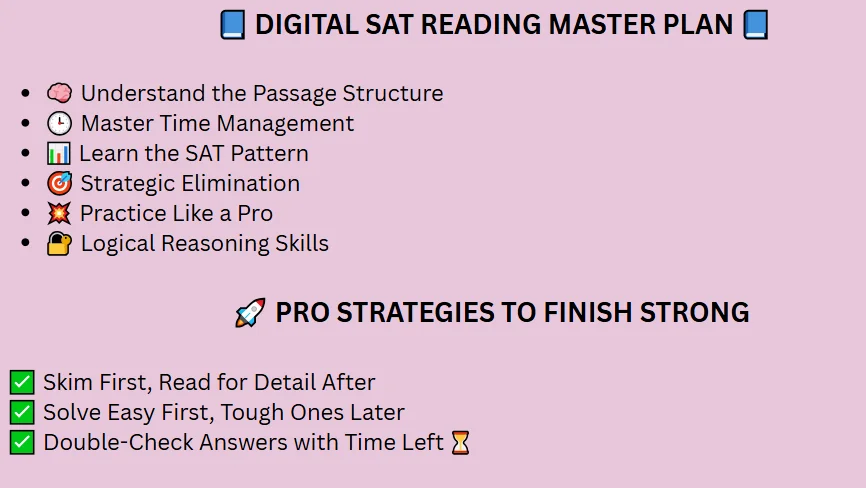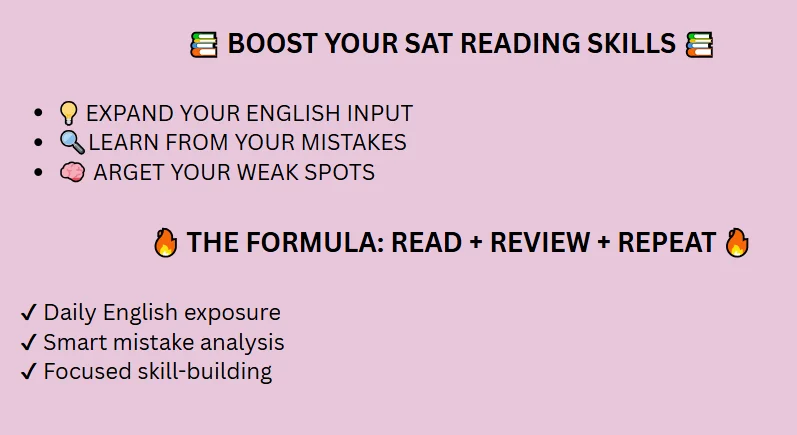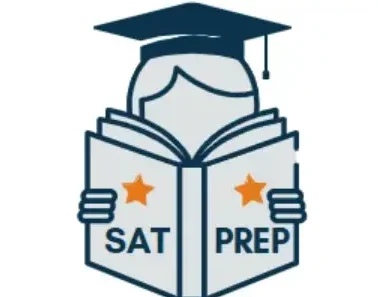For the Preparation of the Digital SAT Reading section, students must implement the right approach and Time Management strategies, and they can improve their accuracy and maximize their Success. Students must know the behavior, structure, and tone of the passage, so students must follow an effective way to prepare for the SAT Reading passage section.
SAT Reading Passages practice test
The most important thing for the preparation of the SAT reading is to know about the pattern and the question types that come in the actual test. Students must understand the passage types, practice strategic elimination, and track correct answer explanations to achieve a perfect SAT Score. The SAT Reading section is very important, but it can be challenging to achieve a perfect SAT Score of 800. Below is a breakdown to prepare effectively for the SAT Reading passage.

Best Sources For the Prep of the SAT Reading Passage
SAT Reading passages PDF with answers
If you are preparing for the SAT Reading section, PDF files are the best choice as they contain complete answers. This material helps you understand the different types of questions and their solutions. The official College Board guides, past papers, and online practice tests give you access to key vocabulary, text interpretation, and correct answers. By downloading these files, you can practice at any time and improve your performance.
Digital SAT Reading Passage practice test
Online practice tests for the digital SAT reading passages make your preparation easy and effective. These tests provide an opportunity to practice in an environment similar to the actual exam. Free and premium tests are available on various websites that test your time management, vocabulary comprehension, and text interpretation skills. Through these tests, you can identify your weaknesses and work on them.
Digital SAT Books For Practicing Reading Passages
Quality books for digital SAT preparation for the different passages play an important role in improving your reading skills. Several authors have created books specifically for the SAT Reading section that include comprehensive exercises, explanations, and solution methods. These books not only expand your vocabulary but also help you understand complex texts. In addition to the official College Board books, books from other reputable publishers are also excellent choices.
Use Official Practice Tests For the Prep of SAT Reading Passage
To prepare yourself for the SAT reading passage, it is compulsory that you get the authentic and reliable study resources that are offered officially. They must meet the actual SAT formats and balance the question weightage as well as difficulty level. This will provide the truest sense of what to expect on the test day.
Always practice the SAT reading and writing from the sat practice test prep and College Board websites. They provide authentic and well-designed study material for your SAT exam preparation. Student can also track their performance at the end of the test.
Prepare for the Logical Reasoning of the Passage
Logical reasoning questions require the ability of the student to think critically and analyze the written material effectively. In the SAT, the reading comprehension passages are included, which are used to test the logical reasoning ability of the student. It includes the following:
- Understanding Passage Types
- Identify Key Details
- Practice Question Types
Know the SAT Reading Passages
The SAT reading section consists of five passages with different topics as well as structural perspectives. So, students must be familiar with them correctly. Students must understand that the reading passage types mostly include
- Literary Fiction: Excerpts from novels or short stories
- Historical Documents: Speeches, letters discussing political or social issues.
- Social Science: Articles on psychology, sociology,y, and economics.
- Natural Science: Passages covering biology, chemistry, physics, and environmental science.
- Paired Passages: Two shorter passages explaining similar or opposing views
Practice Passage by Eliminating Wrong Answers
Students practice selecting the correct answer by focusing on and finding the wrong answers. So, by identifying the three wrong answers, the student can get the fourth correct option. This is the best way to prepare for the practice SAT passage.
- Avoid Extreme Answers
- Match with Evidence
- Beware of Traps
- Compare Remaining Choices
Practice to Finish Early and Check Your Answers
Candidates practice in such a way as to submit their test early before the time, as well as check the answers carefully. Students must focus on the following strategy to practice finishing early.
- Skim First, Read for Details Later: Solve the easy-to-understand passage first the other critical
- Stick to a Time Limit: Practice solving the passage for equal time distribution.
- Double-Check Your Answers: Student must practice in such a way that they have the time to check their answer again.
Improve Your Reading Skills For the SAT Prep
After practicing the daily passage reading, the student must also read other English material like newspapers, watch English shows, watch English movies, and other English-related multimedia, which will improve their English skills.
Learn from Mistakes
In the daily practice of the reading passages, the student must track their mistakes and the correct option. This will make the English concept strong and enable the student’s ability to get higher marks in the SAT reading passage.
Work on Weak Skills
By tracking the correct and the wrong answers, the student now must focus on the weak areas and make them strong. This is the most effective way to get higher marks in the SAT reading sections, as well as the other sections.
Practice, Practice, Practice
Students must focus on the formula of practice, practice, and practice because “practice makes a man perfect”. So, good practice and time spent on the SAT reading passage will reward you with 800 in the SAT reading passage.

FAQ’s
How to get an 800 on the digital SAT reading?
Is digital SAT reading easier?
How to prep for the digital SAT reading?
How many Reading Passages are there in the digital SAT?
The Reading and Writing section of the digital SAT consists of two modules, each with 27 passages, for a total of 54 passages (sometimes some passages are shorter and have more than one question, called paired passages).
How many questions are there in the Reading and Writing section?
There are a total of 54 questions, divided into two 27-question modules. Each passage is followed by a question.
What are the Reading Passages?
The digital SAT includes the following passage types:
- Literature (Nobel, Drama, Poetry)
- History (Speech, Documentary Excerpts)
- Social Studies (Psychology, Economics, etc.)
- Science
- Contemporary Issues (Newspaper or Opinion)
- Occasionally, paired passages are also available, which consist of two short passages.
How long are the passages?
Each passage is between about 25 and 150 words, which is significantly shorter than the 500-700 words of the old SAT.
What skills are tested in the SAT reading passage?
Consists of 4 major skills:
- Information and Ideas (12–14 questions): Understanding the topic, selecting evidence, analyzing graphs/tables
- Craft and Structure (13–15 questions): Understanding word meanings, structure of arguments, connecting two passages
- Expression of Ideas (8–12 questions): Abbreviations, choosing proper words/phrases
- Standard English Conventions (11–15 questions): Grammar and mechanics
What is the proper way to format short passages?
- Read the entire passage slowly and carefully
- Focus on the main meaning and tone
- Annotate: write down keywords/summary/tone, etc.
What is the passage-based method of questions?
- First, understand the question carefully
- Mark the letter where the clue is in the passage
- Mentally predict your answer before answering
- Eliminate wrong answers (extreme, unclear, irrelevant)
- Always prefer the “neutral/boring” answer if in doubt
How to improve reading comprehension?
Read a wide range of topics daily (literature, science, social, current affairs)
